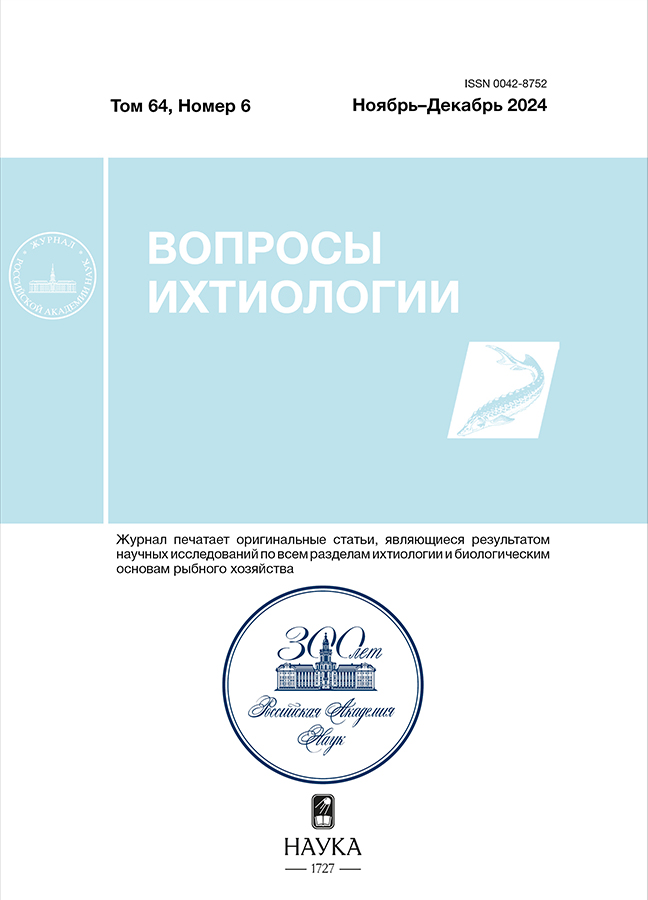Early development of monodactylus argenteus (monodactylidae) from coastal waters of central vietnam, identified with dna barcoding
- Autores: Shadrin A.M.1, Semenova A.V.1,2, Hai Thanh N.T.3
-
Afiliações:
- Moscow State University
- Vavilov Institute of General Genetics, Russian Academy of Sciences
- Coastal Branch, Joint Vietnam–Russia Tropical Science and Technology Research Center
- Edição: Volume 64, Nº 6 (2024)
- Páginas: 750-762
- Seção: Articles
- URL: https://permmedjournal.ru/0042-8752/article/view/681511
- DOI: https://doi.org/10.31857/S0042875224060092
- EDN: https://elibrary.ru/QRXDSQ
- ID: 681511
Citar
Texto integral
Resumo
Late embryonic and early larval development (until first feeding) of Monodactylus argenteus have been studied. The chronology of development and a detailed morphological description of the eggs, embryos, and early larvae are presented. The eggs of M. argenteus were obtained from ichthyoplankton catches from the coastal waters of Central Vietnam and incubated under laboratory conditions at a temperature of about 24°C. The taxonomic identification was performed using the molecular-genetic method of DNA barcoding based on gene cytochrome oxidase 1 subunit (COI) from mitochondrial DNA.
Palavras-chave
Texto integral
Sobre autores
A. Shadrin
Moscow State University
Autor responsável pela correspondência
Email: shadrin-mail@mail.ru
Rússia, Moscow
A. Semenova
Moscow State University; Vavilov Institute of General Genetics, Russian Academy of Sciences
Email: shadrin-mail@mail.ru
Rússia, Moscow; Moscow
N. Hai Thanh
Coastal Branch, Joint Vietnam–Russia Tropical Science and Technology Research Center
Email: shadrin-mail@mail.ru
Vietnã, Nha Trang
Bibliografia
- Шадрин А.М., Семенова А.В., Нгуен Тхи Хай Тхань. 2022. Раннее развитие Pardachirus pavoninus (Soleidae) из Южно-Китайского моря (Центральный Вьетнам), идентифицированного с помощью метода ДНК-баркодинга // Вопр. ихтиологии. Т. 62. № 1. С. 100–116. https://doi.org/10.31857/S0042875222010155
- Akatsu S., Ogasawara Y., Yasuda F. 1977. Spawning behavior and development of eggs and larvae of the Striped Fingerfish, Monodactylus sebae // Jpn. J. Ichthyol. V. 23. № 4. P. 208–214. https://doi.org/10.11369/jji1950.23.208
- Fricke R., Eschmeyer W.N., van der Laan R. (eds.). 2023. Eschmeyer’s catalog of fishes: genera, species, references (http://researcharchive.calacademy.org/research/ichthyology/catalog/fishcatmain.asp. Version 11/2023).
- Froese R., Pauly D. (eds.). 2023. FishBase. World Wide Web electronic publication (www.fishbase.org. Version 11/2023).
- Lasiak T. 1984. The reproductive biology of the moony, Monodactylus falciformis, in Algoa Bay // S. Afr. J. Zool. V. 19. № 3. P. 250–252. https://doi.org/10.1080/02541858.1984.11447888
- Nelson J.S., Grande T.C., Wilson M.V.H. 2016. Fishes of the World. Hoboken: John Wiley and Sons, 752 p. https://doi.org/10.1002/9781119174844
- Randall J.E., Lim K.K.P. Lim K.K.P. 2000. A checklist of the fishes of the South China Sea // Raffles Bull. Zool. Suppl. № 8. P. 569–667.
- Smith W.L, Ghedotti M.J., Domínguez-Domínguez O. et al. 2022. Investigations into the ancestry of the Grape-eye Seabass (Hemilutjanus macrophthalmos) reveal novel limits and relationships for the Acropomatiformes (Teleostei: Percomorpha) // Neotrop. Ichthyol. V 20. № 3. Article e210160. https://doi.org/10.1590/1982-0224-2021-0160
- Thomas D., Kailasam M., Rekha M.U. et al. 2020. Captive maturation, breeding and seed production of the brackishwater ornamental fish silver moony, Monodactylus argenteus (Linnaeus, 1758) // Aquac. Res. V. 51. № 11. P. 4713–4723. https://doi.org/10.1111/are.14816
- Thomas D., Rekha M.U., Angel J.R.J. et al. 2021. Effects of salinity amendments on the embryonic and larval development of a tropical brackishwater ornamental silver moony fish, Monodactylus argenteus (Linnaeus, 1758) // Aquaculture. V. 544. Article 737073. https://doi.org/10.1016/j.aquaculture.2021.737073
Arquivos suplementares















